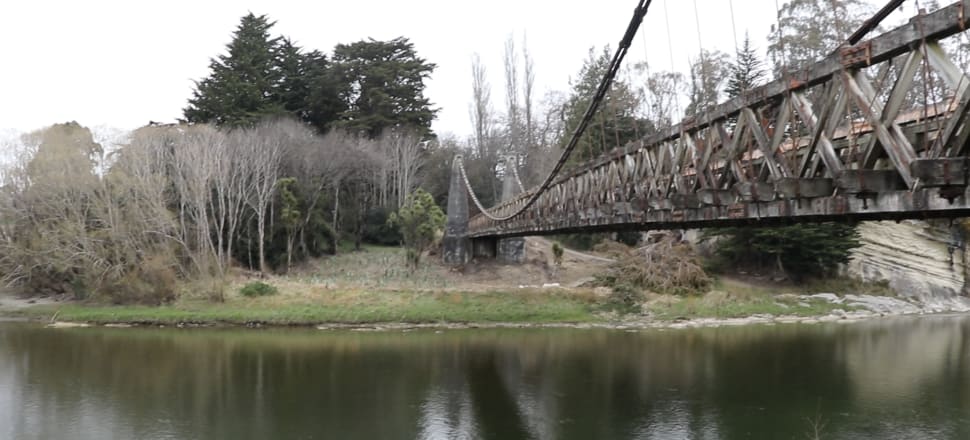
NZ’s largest hydro power station wrestles with a nationally significant river – and the Environment Court. David Williams reports
It’s only by spelling out the gargantuan amount of water serving the Manapōuri hydro-electricity power scheme that you can understand its effect on Southland’s Waiau River.
Paul Marshall, a former Reserve Bank economist who owns a dairy farm in the Waiau catchment, puts it like this: take a one square kilometre area, about the size of Invercargill’s central business district, and extend it vertically 17.3 kilometres into the stratosphere.
That column represents the power scheme’s annual consented take.
“Most jet airliners cruise at around 11,500 metres,” Marshall notes in written evidence filed in the Environment Court.
The power station is allowed to take up to 550 cubic metres a second. That’s 550,000 litres of water – enough to fill an Olympic-sized swimming pool, in less than five seconds.
Manapōuri’s water accounts for about 40 percent of the country’s entire water allocation, including the takes serving all cities, industries and irrigation.
Before 1969, when Manapōuri started generating electricity, water gushed powerfully from Lake Te Anau, through Lake Manapouri, and along the lower Waiau River about 70km to Te WaeWae Bay.
Waiau (said: “why-oh”), in Māori, means “swirling waters” – the Southland river was named for its great, turbulent volume of water .
The once-mighty river was so powerful, Māori said its rapids would tip over mokihi (reed/flax canoes), and the muscular river would wash them out to sea. By 1993, kaumatua said the river was a shadow of its former glory. It had lost its mana.
“Some say that the mauri [life essence or living component] of the river is slumbering, others believe the mauri is dying,” kaumatua said back then. “With its reduced flow the Waiau River can no longer do the job it was ‘naturally’ supposed to do.”
The Waiau was New Zealand’s second-largest river, in terms of discharge. Now, “up to 95 percent” of the river’s former flow is allocated to the power station’s owner, Meridian, says Marshall’s daughter Claire Jordan, a planner.
The English family – which includes in its number Sir Bill English, the former prime minister – has farmed the Dipton-Castlerock area for 140 years. Bill’s grandmother, Deliah Annie O’Brien, purchased Sunnyside farm, on the western banks of the Waiau, in 1937.
As a child, Bill’s brother Hamish, a Dipton farmer, recalls standing with his mother on a swing bridge, high above the river, “hearing the thunder of it passing under the bridge and vibrating through into my feet”.
No longer. The river’s palpable, fear-inducing power is, in the main, gone, a consequence of the country’s drive for renewable electricity – in this case to power an aluminium smelter in Bluff.
(Manapōuri generates enough electricity to supply more than 670,000 average residential customers, or about 12 percent of the country’s total electricity.)
“The life force of the Waiau has been emasculated, and we feel that loss deeply as we reminisce and reflect on our early lives,” English says in evidence to the Environment Court.
All of this evidence – of Marshall and Jordan for their family farm company Aratiatia Livestock Ltd, plus English, and others, such as Meridian, Fish & Game, the Conservation Department, Forest & Bird, and Ngā Rūnanga (collectively, Waihopai Rūnaka, Hokonui Rūnaka, Te Rūnanga o Awarua, Te Rūnanga o Ōraka Aparima, and Te Rūnanga O Ngāi Tahu) – has been submitted ahead of a hearing in Christchurch this week and next.
Technically, the Environment Court hearing is an appeal of the Southland Water and Land Plan, including how the regional council, Environment Southland, will treat the Manapōuri scheme’s resource consents, which expire in 2031.
But the evidence traverses much more, including the cultural and environmental degradation of the emasculated Waiau. It also looks ahead to that rare moment when the promises and projections of various consent hearings years ago, can be contrasted and compared with reality.
By whatever measure – water taken, power produced or its importance to industry – Manapōuri is an unmatched hydro behemoth.
It’s a gargantuan generator which, given the importance of renewable energy in the climate crisis, is arguably growing in importance. But at what environmental cost?
The question being asked now is: can’t some of that water for hydro be used to restore the Waiau?

Lake Manapōuri is nestled into a mountain-hugging corner of Fiordland National Park, part of Te Wahipounamu, a UNESCO world heritage site.
The hydro scheme’s water is stored in the lake and discharged – thanks to incredible feats of engineering – through two 10km-long tunnels into Deep Cove in Doubtful Sound/Patea, on the West Coast. The vertical drop between the two points is 178m.
Manapōuri’s control structure is actually located about 10km from the lakes outflow, down the Waiau River, just beyond the confluence with the Mararoa River, which bolsters inflows to the lake.
Consents for the power station were granted in 1996, five years after the Resource Management Act was passed. This timing was an undoubted win for the Waiau, as previously there were no mandated minimum flows, and it would sometimes run dry.
A second tailrace tunnel was consented in 1998, and started operating in 2002. And in 2010, Meridian gained consent to increase the maximum discharge from 510 cumecs to 550 cumecs. (A cumec is a measure of water flow equivalent to a cubic metre of water, or 1000 litres, flowing past a point in one second.)
Modelling suggested an extra 10 cumecs, on average, would be taken from the Waiau, mainly from higher flows – the floods and freshes. That may not sound like a lot, but Jordan, the planner, says that’s an extra 315 billion litres of water each year.
Nga Rūnanga evidence is the Waiau isn’t healthy, that the loss of water has affected the river’s ecology, and its ability to cleanse itself.
The Waiau is over-allocated, Jordan argues, with very noticeable effects. (Meridian disputes the over-allocation claim.)
Simplistically, low flows means higher temperatures and poorer water quality.
Marshall, the farmer, a founding member and co-chair of environmental group Waiau Rivercare (a party to the appeal), lays out the scheme’s devastating impact on the river:
- Algal blooms, didymo, bank erosion, and weed infestations on islands that used to be riverbed;
- Loss of amenity, including swimmability and fishing;
- Loss of sand and the near total collapse of toheroa (shellfish) beds on Bluecliffs Beach, to the west of the Waiau’s mouth on Te Waewae Bay;
- Te Waewae Bay lagoon being “choked with sediment”, and the mouth not always being open to the sea.
(The river’s minimum flow is 12-16 cumecs, depending on the time of year – compared to a pre-1969 flow of more than 450 cumecs. Consent conditions also mandate five periodic “recreational flows” of 35 cumecs, and a single flow of 150 cumecs each year to open the Waiau Lagoon to the ocean for fish passage, if required by Environment Southland.)
Cultural and heritage expert Ailsa Cain – a Ngāi Tahu representative on statutory group Guardians of Lakes Manapōuri, Te Anau and Monowai – says in her evidence on behalf of Nga Rūnanga, the Waiau is culturally degraded.
“I acknowledge that the mauri of the waterbodies might take generations, if ever, to be restored. However, as kaitiaki, Ngāi Tahu ki Murihiku are bound to do everything in their power to protect and restore its mauri.”
Opponents are not calling for the Manapōuri scheme to cease.
English, the former prime minister’s brother, is careful to say his evidence shouldn’t be taken as a criticism of Meridian, the 51 percent government-owned, NZX- and ASX-listed company that operates the the power station.
“I have no expectation that the flows of the Waiau River will be returned to the flow rates that existed before the commissioning of the scheme.”
The burdens of the scheme should be balanced, English says, and degradation of the Waiau should be stopped, or slowed further.
Cain, for Ngā Rūnanga, says if there’s no balance between mauri and renewable energy, “then any benefit from renewable energy is questionable”.

Before delving into Meridian’s arguments, and its change of heart over Rule 52A, let’s set the scene for the Environment Court hearing.
In Environment Southland’s proposed land and water plan, Meridian sought a change to what’s called the “activity status” of its Manapōuri consents, from discretionary to controlled. If an activity is controlled it restricts the regional council’s consideration of consent renewals. In other words, if certain pre-conditions are met, consents must be granted.
Commissioners considering the proposed plan agreed to Meridian’s request, and inserted controversial Rule 52A, to allow the re-authorisation of the existing Manapōuri consents for the “controlled” activities of the taking or use of water, the discharge of water and contaminants, and the damming and diversion of water.
This went against the advice of council planning officers, who said: “Although the Manapouri Power Station is of significant social and economic benefit, the power station is located within a national park which holds considerable conservation values.
“Given the allocation of water to Meridian and the impact the take has on the Waiau River flows, it is not unquestionable that there may be a need to reconsider the effects of the activity.”
Meridian has tried to protect the power station in other ways.
The 2020 update of the national policy statement for freshwater management (NPS) was brought in to improve degraded water bodies, and maintain or improve all others using national “bottom lines”. Its over-riding theme is Te Mana o Te Wai, prioritising the health of the river above other interests.
But five huge hydro schemes, including Manapōuri, were given specific carve-outs, meaning they didn’t have to achieve bottom lines if that had a significant adverse effect on their operations.
Councils applying the NPS to those catchments – like Environment Southland on the Waiau – also have to consider greenhouse gas emissions, security of electricity supply, and “generation capacity, storage and operational flexibility” when making decisions.
The carveout was achieved by the big power companies lobbying Minister David Parker, which led to workshops with Ministry for the Environment officials.
A November 2018 briefing to Energy and Resource Minister Megan Woods said Meridian’s view was the NPS, without the exceptions, “poses an immediate threat to hydro generation, most particularly for the Manapōuri scheme”.
The briefing mentions the Environment Court appeals. “Once a plan is operative, resource consents can be reviewed prior to their expiry in order to ensure compliance with a regional plan.”
Which is true, but that review might be restricted by the activity status of those consents.
In a 2018 phone call, Meridian’s statutory and compliance strategy manager, Andrew Feierabend, questioned Environment Southland’s policy and planning manager Vin Smith about the ability of Marshall’s Waiau Rivercare Group, and the regional council’s Waiau River Liaison Committee, to join the plan appeal, over whether their interest was greater than that of the general public.
The regional council initially raised the issue with the court. When it later claimed a neutral position on the outcome, Meridian was happy to make submissions.
In his November 2018 decision, Environment Court Judge John Hassan ruled the Rivercare Group had standing, but knocked out the Liaison Committee. (Asked about this, and its lobbying for exclusions to the NPS, the company had no comment.)
Marshall, the Southland farmer, started a Parliamentary petition opposing Manapōuri’s NPS (now gazetted) exclusions.
In August of this year, Meridian’s head of environment, Hamish Cuthbert, wrote to the Environment Select Committee, which is considering the petition, saying it was an “an attempt to litigate, in a different forum, matters which are already before the Environment Court”.
This conveniently overlooks the petition’s target was a specific clause, inserted at the behest of big generators, who were lobbying ministers and officials behind closed doors at about the same time as Meridian was seeking to knock community groups out of the Environment Court appeal.
The resource management process was the appropriate process to resolve these issues, Cuthbert told the committee, pointing to a proposed change to the Southland Land and Water Plan known as Tuatahi, “which should decide these issues in a robust process, with public participation, based on evidence”.
That is, if Rule 52A and the NPS exclusion doesn’t overly constrain the council’s consideration of future flows, and environmental attributes and bottom lines in the Waiau catchment.
“It should be noted the Waiau River has the better water quality of all of the developed catchments in Southland.” – Hamish Cuthbert
Meridian has now told the Environment Court it is seeking – after discussions with Ngā Rūnanga – a “restricted discretionary” activity status for its Manapōuri consents, rather than controlled. (Jordan, the planner who is Marshall’s daughter, prefer a discretionary activity classification, as do several other submitters.)
Meridian’s experts have filed hundreds upon hundreds of pages of evidence, but, helpfully, many of the major themes are covered in Cuthbert’s letter to the Select Committee.
“Meridian considers, based on independent scientific advice, that the issues that have resulted in degradation of water quality and ecology in the lower Waiau River over the last two decades primarily relate to land use change and agricultural intensification in the lower catchment,” he says.
(Jordan says previous plan appeal hearings have discussed regulating farming to improve water quality, but another way contaminants increase in waterways is by decreasing the volume of clean water. “The scheme removes a significant amount of alpine water from the Waiau.”)
Meridian is working on a project to increase the effectiveness of existing flushing flows, which is expected to help improve ecological health of the Waiau River, Cuthbert says in a statement to Newsroom.
In his letter to the committee, Cuthbert zeroes in on the importance of hydro generation to the country’s electricity needs, especially in the context of climate change, and decarbonisation. New renewable generation schemes are heavily weighted towards wind and solar, he says, which “only work when the wind is blowing and the sun is shining”. By contrast, large hydro schemes can store water, and adjust output to meet changes in demand.
A recent national grid upgrade “has greatly enhanced the ability to move large quantities of electricity north” from the power station, Cuthbert says.
“This means that even if there was a significant short-term reduction in electricity demand in the south (for example, if the [aluminium] smelter at Tiwai Point closed) the electricity generated by the MPS [Manapōuri Power Station] is able to be used elsewhere in the country and could immediately reduce the need for ongoing thermal generation while new renewable generation capacity is built and commissioned.
“As demand for electricity grows significantly over the next 20-30 years, and as other forms of flexible generation reduce or cease, the country’s large hydro schemes will become increasingly important. It is essential that the output and flexibility of the large hydro schemes is maintained over that timescale.”
Cuthbert adds: “To do otherwise is likely to seriously impact on our ability as a nation to make the changes we need to in our transport and industrial heat sectors to achieve our decarbonisation target.”
The previously mentioned national policy statement requires freshwater to be managed “as part of New Zealand’s integrated response to climate change”.
Yes, the hydro schemes’ carve-out means “target attribute states” can be below national bottom lines ion their catchments. But, Cuthbert says, a regional council “must still look to achieve an improved attribute state to the extent practicable” – as long as that doesn’t adversely affect the power station’s ability to meet other national priorities, like emissions targets, and maintaining electricity supply.
The Meridian manager tries to pick apart the arguments of Marshall and others.
He says Manapōuri’s generation flows can peak at 550 cumecs but “the ability to take that amount of water is constrained by the need to maintain lake levels”, meet Waiau River’s minimum flows, and manage spills during floods.
It’s inevitable large hydro schemes have significant impacts on their local rivers and catchments, Cuthbert writes.
While Marshall says the power station’s operation has accelerated a decline in the Waiau’s water quality since 2010, Meridian blames increased sedimentation and contaminant loadings on “land use change and intensification”.
“It should be noted the Waiau River has the better water quality of all of the developed catchments in Southland,” Cuthbert says.
If what Marshall wants is increased minimum flows, that needs to be fed into the development of the next regional plan, which implements the NPS in the Waiau – while taking into account any effect on Manapōuri.
Southland’s regional council has that plan process “in hand”, Cuthbert says.
In his letter to the committee, Cuthbert concludes by saying Meridian Energy takes seriously its responsibilities to operate Manapōuri in an environmentally responsible and sustainable manner.
It’s not a view shared by Marshall, who has long had dealings with the energy giant.
He tells the Environment Court the regional council must retain flexibility to ensure Manapōuri’s adverse effects are “avoided, mitigated or remedied”.
“My experience with Meridian. both as a ratepayer and in my capacity as a community elected Co-Chair of the [Waiau River Liaison Committee], leads me to believe that unless Meridian is compelled to avoid, mitigate or remedy, Meridian is unlikely to do so.”
Marshall finishes his evidence: “Te mana o Te Waiau.”
A powerful argument from Māori is their voice has been mute to date: Manapōuri’s enabling legislation was passed in the 1960s, and the consents granted in 1996, before the Ngāi Tahu Treaty Settlement was signed in 1998.
If the Manapōuri consents, expiring in 2031, are rolled over for another 35 years without meaningful input from mana whenua, might that mean they will have to wait a century for Ngāi Tahu interests to be appropriately considered?
Ailsa Cain, the Ngā Rūnanga expert on culture and heritage, says in her evidence the Waiau highlights numerous competing interests, with hydro-generation at the forefront.
“This dominance by one use does not mean that other interests should not be provided for or diminished. Equity is critical to restoring the mauri of the Waiau.”
As the whakataukī (proverb) goes: Toitu te marae o Tane
Toitu te marae o Tangaroa
Toitu te Iwi
“When the land and waters are strong, so are the people.”







